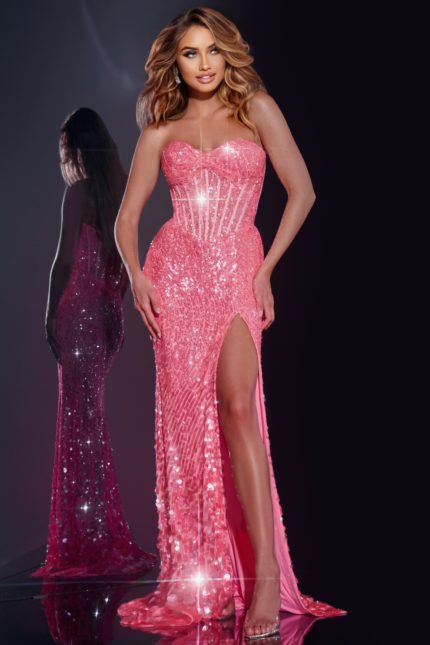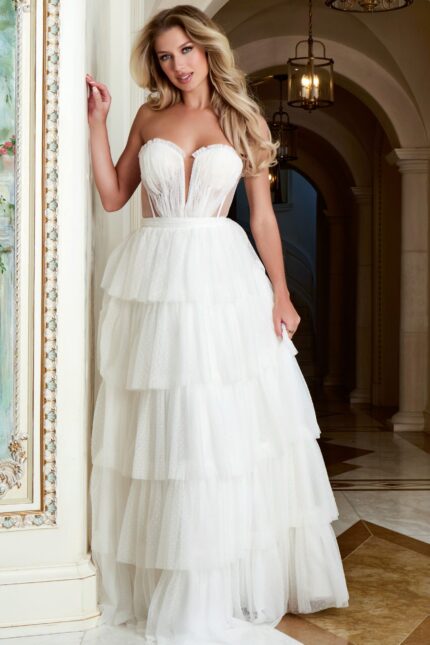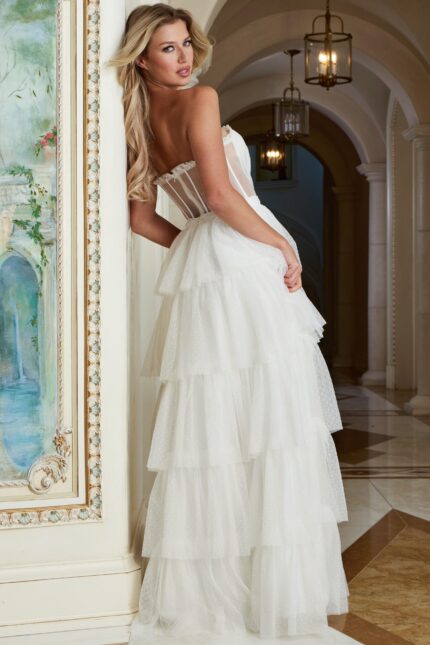Showing 1–36 of 894 results
Prom Dresses
Explore our latest prom dresses, complete with show-stopping ballgowns, flattering mermaid styles, and elegant backless designs to make your prom night unforgettable. Whether you're going for timeless glamour or a bold, trendy look, there's a dress that fits your style. Feel confident, stand out, and create memories that last a lifetime.
Your Guide to the Ultimate Prom Dresses Experience
Prom isn’t just an event, it’s a defining milestone, a collection of moments and memories that you’ll revisit long after the party ends. We understand the magic of prom night – it’s what we do! Our prom dresses aren’t just gowns; they’re the stories you’ll tell again and again, the memories that pop up at random. Each one beautifully tailored to reflect your personal style, elegance, and uniqueness.
Explore Stunning Prom Dress Styles
Every Jovani prom gown is thoughtfully designed, ensuring there’s something perfect just for you:
- Classic A-Line Prom Dresses
Always effortlessly romantic and universally flattering, our A-line gowns feature fitted bodices and gracefully flared skirts. Designed to flow smooth & gently, this style enhances your figure while allowing freedom of movement — which is going to be perfect for dancing all night.
- Glamorous Mermaid Prom Dresses
For prom-goers seeking bold sophistication, our mermaid dresses celebrate curves mixing elegance with a healthy dose of drama. Gently hugging your figure before dramatically flaring near the knees, this silhouette creates a confident, unforgettable presence that lasts well beyond the final dance.
- Sleek Sheath and Column Prom Dresses
Our sheath dresses offer contemporary, minimalist elegance. Designed to subtly trace your silhouette, these gowns radiate understated charm and effortless confidence — ideal for those who appreciate refined simplicity.
- Fairytale Ballgown Prom Dresses
Perfectly suited for dreamers, ballgowns capture that classical prom spirit with voluminous skirts and delicately fitted bodices. Tulle, chiffon, and satin create a look of whimsical beauty, ensuring your prom night will feel nothing short of a genuine Fairytale!
Choose Your Perfect Neckline
The neckline sets the stage for your entire prom look, and we offer carefully designed options to complement your unique personality:
- Timeless Sweetheart Necklines
Feminine and flattering, our sweetheart neckline gently accentuates your shoulders and neckline, perfect for a romantic yet sophisticated look.
- Bold and Beautiful V-Necks
A V-neck dress commands attention, beautifully elongating your figure and adding modern, refined elegance ideal for an unforgettable entrance.
- Graceful Off-Shoulder Necklines
Off-shoulder prom gowns elegantly frame your neckline and shoulders, balancing the sophisticated with the effortless.
- Striking One-Shoulder Designs
Make an unforgettable statement with a contemporary one-shoulder neckline, bringing unexpected drama and a stylish asymmetrical flair to your prom ensemble.
- Elegant Halter Necklines
Halter prom gowns gracefully highlight your shoulders and frame your face, creating sophisticated lines perfect for confident style.
Luxurious Fabrics Chosen for You
Each fabric at Jovani is carefully selected to ensure your prom gown feels as incredible as it looks:
Flowing Chiffon
Chiffon moves with a dreamlike ease, offering you pure comfort and graceful movement – which you’ll find ideal for dancing.
Silky Satin
Luxurious satin gowns provide structured elegance, a gentle sheen, and a sense of exclusive glamour, perfect for making lasting impressions.
Soft Lace
Detailed lace adds texture, depth, and vintage charm, bringing subtle sophistication and romantic beauty to your prom dress.
Airy Tulle
Perfect for creating volume without weight, tulle gowns deliver a whimsical and youthful elegance, turning prom night into your fairytale moment.
Discover Your Ideal Color Palette
Our curated color palettes ensure you find a shade that resonates perfectly with your personality and prom night vision:
Romantic Pastels
Soft blush, gentle lavender, and subtle champagne shades are sure to create timeless romance and delicate sophistication ideal for classic prom elegance.
Bold Jewel Tones
Deep emerald greens, vibrant sapphires, and striking ruby reds provide sophisticated drama, capturing attention while maintaining refined elegance.
Timeless Neutrals
Classic black, ivory, and soft grays will offer you versatile elegance, effortlessly transitioning from prom night to future formal occasions.
Essential Prom Accessories to Complete Your Prom Dress Look
The perfect prom ensemble extend beyond the dress itself – the trick is to have thoughtfully selected accessories complete your prom dress:
- Jewelry: Complement your gown with subtle pieces like delicate necklaces, refined bracelets, or elegant earrings.
- Footwear: Choose stylish heels or chic flats that provide elegance and comfort throughout the evening.
- Clutches & Bags: Carry sleek, sophisticated bags or clutches in materials like satin, velvet, or metallic finishes, adding practicality and style.
- Sizing & Alterations Made Easy: Jovani believes your perfect fit should never be complicated.
Follow these simple steps for flawless sizing:
Measure accurately: Bust, waist, and hips.
Consult our detailed sizing guide: Find your ideal match effortlessly.
Tailoring Advice: If between sizes, choose slightly larger for customized comfort through professional alterations.
Common Question We’re Asked
When should I order my Jovani prom dress?
We recommend purchasing your gown four to six weeks before your event to ensure stress-free alterations, accessory selections, and ample preparation time.
Which prom dress style will flatter my body best?
We design silhouettes for all body types: With A-line and ballgowns flattering universally, mermaid and sheath styles emphasizing your curves beautifully, and column dresses offer that sleek, minimalist elegance.
How do I select the perfect prom dress color?
Consider your personal style, skin tone, and prom night vision. Pastels convey romance, jewel tones offer sophistication, with the neutrals providing timeless elegance.
Are Jovani prom dresses suitable for other formal events?
Absolutely – Yes! Our gowns offer versatile designs ideal for weddings, formal dinners, gala events, cocktail parties, and other sophisticated occasions.
Why Choose Jovani for Prom Night?
Our mission goes beyond creating beautiful dresses. We’re dedicated to crafting gowns that become central to your most cherished memories, blending meticulous detail, timeless elegance, and unparalleled comfort. When you choose Jovani, you’re investing in more than a dress – you’re investing in an unforgettable experience.
Discover your dream prom gown at Jovani today, and let your prom night become an occasion you’ll treasure forever.








































































